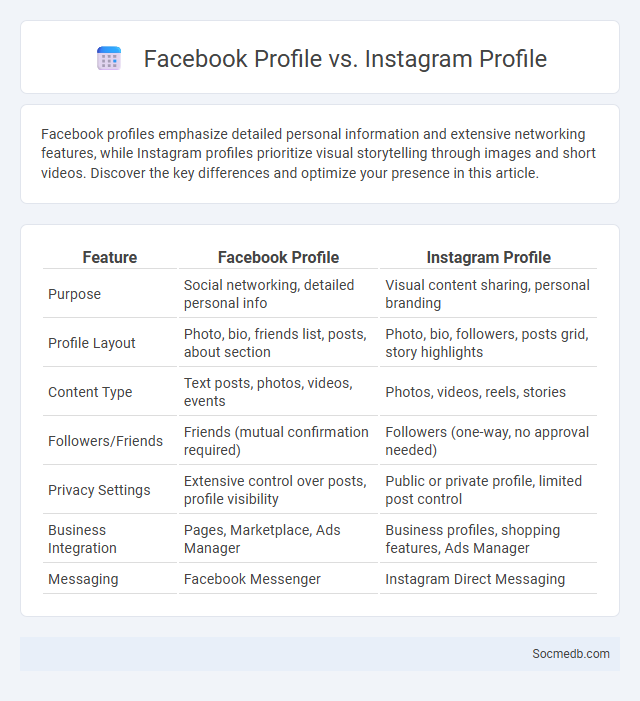
Photo illustration: Facebook Profile vs Instagram Profile
Facebook profiles emphasize detailed personal information and extensive networking features, while Instagram profiles prioritize visual storytelling through images and short videos. Discover the key differences and optimize your presence in this article.
Table of Comparison
| Feature | Facebook Profile | Instagram Profile |
|---|---|---|
| Purpose | Social networking, detailed personal info | Visual content sharing, personal branding |
| Profile Layout | Photo, bio, friends list, posts, about section | Photo, bio, followers, posts grid, story highlights |
| Content Type | Text posts, photos, videos, events | Photos, videos, reels, stories |
| Followers/Friends | Friends (mutual confirmation required) | Followers (one-way, no approval needed) |
| Privacy Settings | Extensive control over posts, profile visibility | Public or private profile, limited post control |
| Business Integration | Pages, Marketplace, Ads Manager | Business profiles, shopping features, Ads Manager |
| Messaging | Facebook Messenger | Instagram Direct Messaging |
Understanding Facebook Profiles: Key Features
Facebook profiles offer a comprehensive snapshot of your online identity, showcasing personal details such as work history, education, and interests. Key features include the timeline for sharing updates, photos, and life events, as well as privacy settings that control who can view your information. Your profile picture and cover photo visually represent you, making your profile easily recognizable to friends and potential connections.
Instagram Profiles: What Sets Them Apart
Instagram profiles distinguish themselves through visually cohesive content, strategically curated highlights, and consistent branding that resonates with their target audience. High engagement rates often correlate with authentic storytelling and the strategic use of features like Reels, IGTV, and Stories to maximize reach. Leveraging data analytics for audience insights enables profiles to refine content strategies, boosting follower growth and interaction quality.
The Concept of a ‘Profile’: Beyond Facebook and Instagram
A social media profile serves as a digital representation of an individual or brand, encapsulating personal information, interests, and content shared across platforms like LinkedIn, Twitter, and TikTok. Profiles enable tailored interactions and influence algorithms that customize user experiences, playing a critical role in identity formation and network building beyond popular sites like Facebook and Instagram. Advanced features such as privacy controls, multimedia integration, and real-time updates enhance the profile's function as a dynamic social and professional tool.
Visual Layouts: Facebook vs Instagram vs General Profiles
Facebook prioritizes a multi-column visual layout emphasizing diverse content types, such as text posts, events, and groups, tailored for in-depth user interaction. Instagram focuses on a streamlined, grid-based design optimized for high-impact visual storytelling through images and short videos, enhancing aesthetic appeal and user engagement. General social media profiles often blend text and media but lack the specialized, platform-specific layouts that Facebook's comprehensive structure and Instagram's visual-centric interface provide.
Privacy Settings Comparison: Customizing Your Digital Presence
Social media platforms offer diverse privacy settings that enable you to control who sees your personal information, posts, and activity. Customizing these settings on Facebook, Instagram, and Twitter helps protect your digital presence by limiting data exposure and enhancing security. Understanding the differences in privacy options across platforms allows you to tailor your online visibility according to your preferences and safety needs.
Audience Engagement: Platform-Specific Differences
Audience engagement varies significantly across social media platforms due to differences in content format and user behavior. For example, Instagram's visual-centric approach encourages high interaction through likes, comments, and stories, while Twitter thrives on concise, real-time conversations generating rapid responses and trending topics. Understanding these platform-specific differences allows you to tailor your content strategy effectively, maximizing engagement with your target audience.
Content Types: What You Can Share on Each Profile
Facebook allows you to share a diverse range of content including photos, videos, status updates, live streams, and events, making it ideal for personal stories and community engagement. Instagram focuses on high-quality images, short videos, Stories, and Reels, which are optimized for visual storytelling and brand promotion. LinkedIn supports professional content such as articles, job updates, industry news, and in-depth posts, helping you build your professional network and establish thought leadership.
Growth and Networking: Which Profile Suits Your Needs?
Choosing the right social media profile is crucial for optimal growth and networking; LinkedIn excels for professional connections and B2B opportunities, while Instagram attracts creative industries and lifestyle brands seeking visual engagement. Twitter supports real-time interaction and thought leadership, ideal for influencers and experts aiming to expand their audience through concise content. Facebook offers diverse group features and community-building tools, suitable for businesses targeting local markets and fostering long-term customer relationships.
Branding Potential: Leveraging Profiles for Business or Personal Use
Social media profiles offer immense branding potential by allowing you to showcase your unique identity and values effectively to a global audience. Strategic content creation and consistent messaging across platforms enhance brand recognition and credibility, driving engagement and growth. Optimizing your profiles with professional visuals and targeted keywords ensures maximum visibility and impact in competitive markets.
Choosing the Best Profile Platform for Your Goals
Selecting the best social media profile platform depends on your specific goals and target audience. For professional networking and business growth, LinkedIn offers robust tools to showcase your expertise and connect with industry leaders. If your aim is visual storytelling and brand engagement, Instagram's features and active user base provide a highly effective environment for reaching your audience.
 socmedb.com
socmedb.com